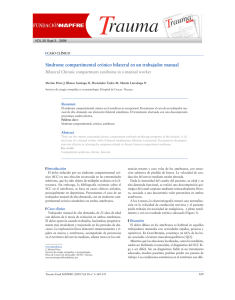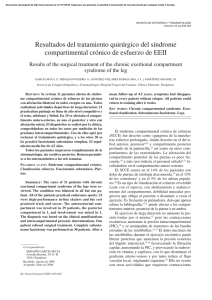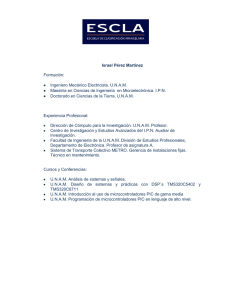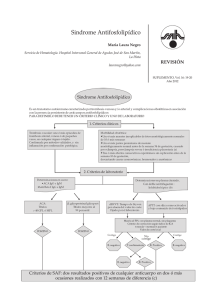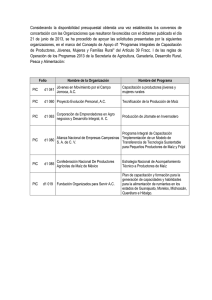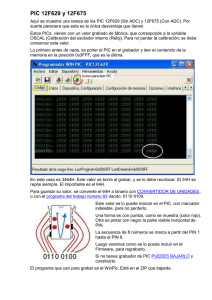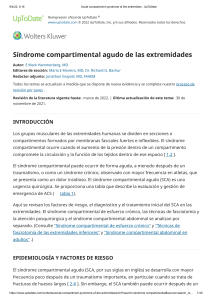resumen comunicación / póster
Anuncio
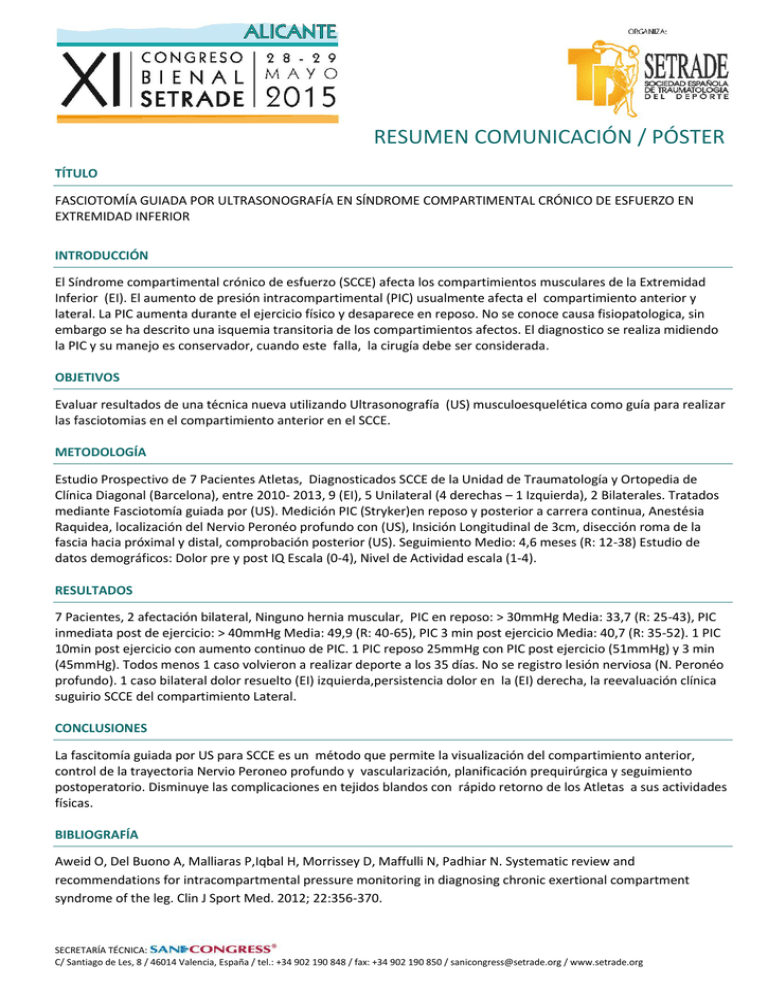
RESUMEN COMUNICACIÓN / PÓSTER TÍTULO FASCIOTOMÍA GUIADA POR ULTRASONOGRAFÍA EN SÍNDROME COMPARTIMENTAL CRÓNICO DE ESFUERZO EN EXTREMIDAD INFERIOR INTRODUCCIÓN El Síndrome compartimental crónico de esfuerzo (SCCE) afecta los compartimientos musculares de la Extremidad Inferior (EI). El aumento de presión intracompartimental (PIC) usualmente afecta el compartimiento anterior y lateral. La PIC aumenta durante el ejercicio físico y desaparece en reposo. No se conoce causa fisiopatologica, sin embargo se ha descrito una isquemia transitoria de los compartimientos afectos. El diagnostico se realiza midiendo la PIC y su manejo es conservador, cuando este falla, la cirugía debe ser considerada. OBJETIVOS Evaluar resultados de una técnica nueva utilizando Ultrasonografía (US) musculoesquelética como guía para realizar las fasciotomias en el compartimiento anterior en el SCCE. METODOLOGÍA Estudio Prospectivo de 7 Pacientes Atletas, Diagnosticados SCCE de la Unidad de Traumatología y Ortopedia de Clínica Diagonal (Barcelona), entre 2010- 2013, 9 (EI), 5 Unilateral (4 derechas – 1 Izquierda), 2 Bilaterales. Tratados mediante Fasciotomía guiada por (US). Medición PIC (Stryker)en reposo y posterior a carrera continua, Anestésia Raquidea, localización del Nervio Peronéo profundo con (US), Insición Longitudinal de 3cm, disección roma de la fascia hacia próximal y distal, comprobación posterior (US). Seguimiento Medio: 4,6 meses (R: 12-38) Estudio de datos demográficos: Dolor pre y post IQ Escala (0-4), Nivel de Actividad escala (1-4). RESULTADOS 7 Pacientes, 2 afectación bilateral, Ninguno hernia muscular, PIC en reposo: > 30mmHg Media: 33,7 (R: 25-43), PIC inmediata post de ejercicio: > 40mmHg Media: 49,9 (R: 40-65), PIC 3 min post ejercicio Media: 40,7 (R: 35-52). 1 PIC 10min post ejercicio con aumento continuo de PIC. 1 PIC reposo 25mmHg con PIC post ejercicio (51mmHg) y 3 min (45mmHg). Todos menos 1 caso volvieron a realizar deporte a los 35 días. No se registro lesión nerviosa (N. Peronéo profundo). 1 caso bilateral dolor resuelto (EI) izquierda,persistencia dolor en la (EI) derecha, la reevaluación clínica suguirio SCCE del compartimiento Lateral. CONCLUSIONES La fascitomía guiada por US para SCCE es un método que permite la visualización del compartimiento anterior, control de la trayectoria Nervio Peroneo profundo y vascularización, planificación prequirúrgica y seguimiento postoperatorio. Disminuye las complicaciones en tejidos blandos con rápido retorno de los Atletas a sus actividades físicas. BIBLIOGRAFÍA Aweid O, Del Buono A, Malliaras P,Iqbal H, Morrissey D, Maffulli N, Padhiar N. Systematic review and recommendations for intracompartmental pressure monitoring in diagnosing chronic exertional compartment syndrome of the leg. Clin J Sport Med. 2012; 22:356-370. SECRETARÍA TÉCNICA: C/ Santiago de Les, 8 / 46014 Valencia, España / tel.: +34 902 190 848 / fax: +34 902 190 850 / sanicongress@setrade.org / www.setrade.org RESUMEN COMUNICACIÓN / PÓSTER Barnes M. Diagnosis and management of chronic compartment syndromes: a review of the literature. Br J Sports Med. 1997;31:21-27. Cardinal E, Chhem RK, Beauregard CG. Ultrasound-guided interventional procedures in the musculoskeletal system. RadiolClin North Am 1998;36:597. Davis DE, Raikin S, Garras DN, Vitanzo P, Labrador H, Espandar R. Characteristics of Patiens With C hronicExertional Compartment Syndrome. Foot Ankle Int 2013; 34: 13491354 Dharm-Datta S, Minden DF, Rosell PA, et al. Dynamic pressure testing for chronic exertional compartment syndromein the UK military population. J R Army Med Corps. 2013;159:114-118. Due J Jr, Nordstrand K. A simple technique for subcutaneous fasciotomy. ActaChirScand1987;153:521-522. EdmunsonD, Toolanen G. Chronic exertional compartment syndrome in diabetes mellitus. Diabet Med 2011; 28:8185 Finestone AS, Noff M, Nassar Y, Moshe S, Agar G, Tamir E. Management of Chronic Exertional Compartment Syndrome and Fascial Hernias in the Anterior Lower Management of Chronic Exertional Compartment Syndrome and Fascial Hernias in the Anterior Lower. Foot Ankle Int2014 35: 285-292 Fronek J, Mubarak SJ, Hargens AR, et al. Management of chronic exertional anterior compartment syndrome of the lower extremity. ClinOrthopRelat Res 1987;220:217-227. Hislop M, Tierney P. Intracompartmental pressure testing: results of aninternational survey of current clinical practice,highlighting the need for standardised protocols. Br J Sports Med. 2011;45:956-958. Hutchinson MR, Bederka B, Kopplin M. Anatomic structures at risk during minimal-incision endoscopically assisted fascia compartment releases in the leg. Am J Sports Med 2003; 31:764–769 Kitajima I, Tachibana S, Hirota Y, Nakamichi K, Miura K. One-portal technique of endoscopic fasciotomy: Chronic compartment syndrome of the lower leg. Arthroscopy 2003;17:E33. Knight JR, Daniels M, Robertson W. EndoscopicCompartment Release for ChronicExertionalCompartmentSyndrome. ArthroscopyTechniques 2013; 2:87-90 Leversedge FJ, Casey PJ, Seiler JG, Xerogeanes JW. Endoscopicallyassistedfasciotomy: Description of techniqueand in vitro assessment of lower-legcompartmentdecompression. Am J SportsMed 2002;30:272-278. Lohrer H, Nauch T. Endoscopicallyassisted release for exerctional compartiment síndromes of thelower leg. ArchOrthop Trauma Surg 2007; 127. 827-834 Liu SS, Ngeow JE, YaDeau JT. Ultrasound-Guided Regional Anesthesia and Analgesia A Qualitative Systematic Review. RegAnesth Pain Med 2009;34: 47-59 SECRETARÍA TÉCNICA: C/ Santiago de Les, 8 / 46014 Valencia, España / tel.: +34 902 190 848 / fax: +34 902 190 850 / sanicongress@setrade.org / www.setrade.org RESUMEN COMUNICACIÓN / PÓSTER Marhofer P, Chan VWS. Ultrasound-Guided Regional Anesthesia: Current Concepts and Future Trends. AnesthAnalg 2007;104:1265–9 Mavor GE. The anterior tibial syndrome. J BoneJointSurg Br 1956; 38:513-517. Mouhsine E, Garofalo R, Moretti B, Gremion G, Akiki A. Two minimal incision fasciotomy for chronic exertionalcompartment syndrome of the lower leg. Knee Surg Sports TraumatolArthrosc2006; 14:193–197 Ota Y, Senda M, Hashizume H, Inoue M. Chroniccompartmentsyndrome of the lowerleg: A newdiagnosticmethodusingnear-infraredspectroscopyand a newtechnique of endoscopicfasciotomy. Arthroscopy 1999;15:439-443. Pedowitz RA, Hargens AR, Mubarak SJ, Gershuni DH. Modified criteria for the objective diagnosis of chronic compartment syndrome of the leg. Am J Sports Med. 1990; 18:35-40. Peer S, Kovacs P, Harpf C, Bodner G. High-resolution sonography of lower extremity peripheral nerves: anatomic correlation and spectrum of disease. J Ultrasound Med. 2002 Mar;21(3):315-22. PMID: 11883543 Reneman RS. The anterior andthe lateral compartmentalsyndrome of thelegdue to intensiveuse of muscles. Clin Orthop Relat Res 1975;113:69-80. Sebik A, Dogan A. A technique for arthroscopic fasciotomy for the chronic exertionaltibialis anterior compartment syndrome. Knee Surg Sports TraumatolArthrosc2008;16:531-534. Stein DA, Sennett BJ. One-portal endoscopically assistedfasciotomy for exertional compartment syndrome.Arthroscopy 2005;21:108-112. Sofka CM, Collins AJ, Adler RS. Use of ultrasonographic guidance in interventional musculoskeletal procedures: a review from a single institution. J Ultrasound Med 2001;20:21-26. Tucker AK. Chronic exertional compartment syndrome of the leg. Curr RevMusculoskelet Med 2010; 3:32–37 Wittstein J, Moorman CT III, Levin LS. Endoscopiccompartment release for chronic exertional compartmentsyndrome: surgical technique and results. Am J Sports Med2010;38:1661-1666 SECRETARÍA TÉCNICA: C/ Santiago de Les, 8 / 46014 Valencia, España / tel.: +34 902 190 848 / fax: +34 902 190 850 / sanicongress@setrade.org / www.setrade.org
